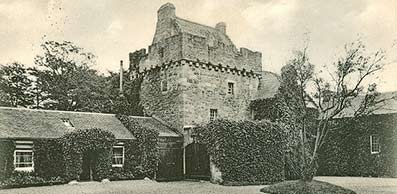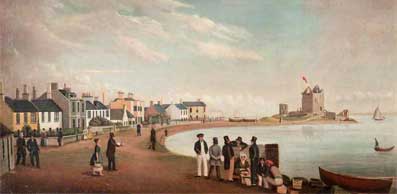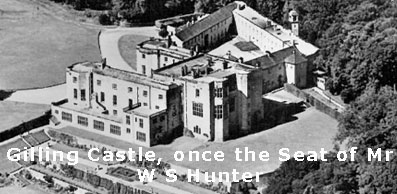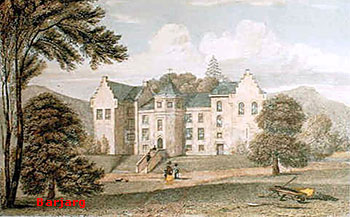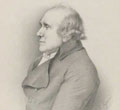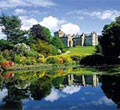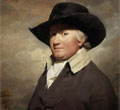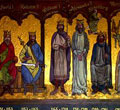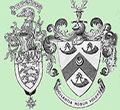History of Hunter
part two
The next on record is William Huntar of Arneil, or Ardneil, who obtained a Crown Charter from King Robert II., "for faithful services rendered" to that monarch, of all that land of Arnele which had been held by "Andre Cambell militis," and had been duly resigned by him. This ancient charter, which is in excellent preservation, is the earliest original document now in the possession of the family, and is dated at Stirling the second day of May, in the fourth year of the King's reign (a.d. 1374).
It would seem probable that the lands granted to Norman Huntar, and held by his descendants down to Aylmer de la Huntar - whom we have seen was an adherent of John Baliol - were forfeited in the wars of succession either by Aylmer, or, as appears more probable, by his immediate descendant, of whose name, consequently, no record, as we have stated, has been preserved.
Sir Andrew Campbell was doubtless the Knight of Loudon who was Sheriff of Ayr in 1367, and who died in the reign of Robert II., and he and his father, Sir Duncan, may have held the estate during the reigns of Robert I. and David II., William Huntar only obtaining reinstatement of the change of dynasty "for faithful services rendered" to King Robert II.
It is possible, however, that Sir Andrew Campbell may have held the lands temporarily on a grant of non-entry from the Crown, such being a casualty of ordinary occurrence, the Crown enjoying the privilege of giving away the non-entry or escheat of its vassals.
As the next Laird of Arnele-Huntar on record, paid on his entry, eleven years arrears of blench-duty, duly accounted for in the Exchequer Roll for 1447, in addition to the double fee as entry money, it may be concluded that William Huntar died about the year 1436, and that his successor, whose name has not come down to us, died in the interval between 1436 and 1447, without paying fees on entry; the next laird on record being probably the grandson of the above-named William Huntar..
William Huntar of Arnele-Huntar, was infeft in his estate prior to 1447, as appears from the subjoined extract from the Exchequer Rolls, the duplication of the blench-duty of one penny in silver being payable to the Crown on entry only : - "Idem compotans onerat se, &c. &c. &c. Et de IId. de albe firme per duplicationem terrarum de Arnele-Huntar per sasinam datam Willo. Huntar de eisdem. Et de XId. albe firme dictarum terrarum de Arnele-Huntar de undecim annis infra hoc computum."
This compt is dated 26th June, 1447.
He was infeft in Hielies, in the Barony of Dalry, on 5th March, 1452, as appears from a charter by Andw. Lyn of that Ilk, and an instrument following thereon, executed at Irvine on that date, Archibald Craufurd of Pryveke, Alexr. Huntar, and John Huntar being among the witnesses.
In 1453 he is recorded in the Exchequer Roll as Custos or Hereditary Keeper of the Forest of the Little Cumray, an island which was then a Royal Forest, well stocked with deer and rabbits, and affording pasturage to a certain number of cattle.
On the erection of the Principality of Scotland by Robert III. in 1404, this island was included in its domains. Munroe, who visited it in 1584, calls it "Cumbray of the Dais, because there is many Dayis intill it;" but they have entirely disappeared, and the remembrance of their existence is not even preserved traditionally in the locality. The rabbits are, however, still extremely numerous, and tend to raise to a very respectable amount the rental of the island.
The salary of the Hereditary Forester was at first twenty shillings per annum, and subsequently two chalders of oats, which was continued to the Earl of Eglintoun on his obtaining possession of the Little Cumbray in 1535, as appears by the following extract from an order by James Colvile, Comptroler to the Sheriff of Bute, dated 28th November, 1586 :- "Schirreff of Bute : Ze sall answer and pay to my Lord of Eglintoun twa chalder of aittis of this last zeir bigane, siclik as ze did to the Lard of Hunterstoun, for Litil Cumray ........And giff ze failze hereintill, I haiff ordanit to put ze to the horne, for I haiff ressauit fra the said Erll payment as vse and wont is."
Certain rights of pasturage, and probably other contingent perquisites, were attached to the office. William Hunter died about the year 1454, and was succeeded by his son, Archibald Huntar of Arnele-Huntar, who not being of age at his father's death, was not infeft in the estate until 1456, and for the same reason John Huntar above-mentioned obtained, on the death of his brother William, the office of Hereditary Forester, which he retained during the lifetime of his nephew. This John had a son named Archibald, who was appointed Receiver of the salary on his father's account, as is shown by the Roll of 1465.
Prior to 1462, Archibald Huntar married Margaret Ker, daughter of William Ker, laird of Kersland, as appears from the following Discharge by his cousins, Robert Crawfurde of Auchinhames, and Archibald Crawfurde of Pryveke, dated 14th June, 1462:- "Be it maide kennyt till all men be thir present letteris, ws Robert Crawfurde off Auchinhamis, ande Archibalde Crawfurde off Pryveke, conjunctly and severally, till hafe resawyte and fullely till haffe hade, be the handis off ane vorschipfull man, Vilzame Ker, Larde of Kerislande, in dawry, ane hundreth mark off vsuale mone off the kynric off Scotland, for all and hall the sovme acht till ws be the said Vilzam for the marriage off oure cusynge Archibalde Huntar, Larde off Ardneill; pertenande till ws, the quhilk forsuth mariage we sellyt and gaffe to the saide Vilzame Ker, to his dochtir Margarete Ker, for the sayde sovme of ane hundreth mark as sayde is; Off the quhilk forsayde sovme of ane hundreth mark, we halde ws weyll content ande payit, and in all thinge acht for the saide mariage fullely assythit for euermar ; and the forsayde Vilzame, his ayeris and all vtheris quham it afferis, or may affer, for ws, our ayeris, and all vtheris quhilkis has or may haffe thar off be law or resoun ony interes, quhitclamys be thir oure presente letteris: In witnes off the quhilk thing we the said Robert Crawfurde and Archibalde Crawfurde to thir oure present letteris of quhitclame and discharge we haff hungyng oure propir seillis, at Achinhamys, the forten day off the moneth off June the yher off oure Lorde a thousande four hundreth sexty and twa yheris."
He died prior to 1487, in which year his son, John Huntar of Huntarstoune or of that Ilk was infeft in his estate, and paid dues on his sasine in the lands of Almolach (Holy Isle, or Lamlash) and in the office of Hereditary Forester. He received his fee of twenty shillings at Custos of the Little Cumbray until 1461, in the compt of which year he is paid "for that time only, as the King receives no advantage from that island." The salary was probably restored when King James IV. was in Bute, in 1495, as John Huntar was paid the usual sum in the accounts of 1496, and the years following.
He married Margaret, daughter of John, Second Lord Cathcart, by Margaret, daughter of Sir William Douglas of Drumlanrig.
(So designed in Sasine, 9th April, 1511. The name of the estate having been evidently changed from " Ardneil," or " Arnele-Huntar," to " Huntarstoune," between the years 1462 and 1511.)
He (John) was infeft in the lands of Hielies on the 9th April, 1511.
He was killed at Flodden on the 9th September, 1513, and was succeeded by his son.
Robert Huntar of Huntarston or of that Ilk, who was a minor at the time his father fell, but who was infeft by John Lyn of that Ilk, as superior of the lands of Hielies, on the 6th May, 1515. He married Jonet, daughter of John Montgomerie of Giffen, a branch of the Eglintoun family, and widow of John Craufurd of Craufurdlaud, between that date and 1522, as he resigned Hielies in the hands of the superior, and was again infeft, along with his wife, in conjunct fee, on the 7th November of that year.
During the troublous times consequent upon the Battle of Flodden and the minority of James V., the Royal Forest of the Cumray was overrun by those - with whom right - was might, and the young laird of Hunterston finding himself powerless to prevent their aggressions "without supply or help" seems to have represented the matter to the King, and prayed for assistance, for on this ground the Regent Albany, in the name of the King, granted, on the 28th October, 1525, a charter to Hugh, first Earl of Eglintoun, as "Fiar, Correkar, and supplear of the ile of Litill Comeray," setting forth, after the customary preamble, that . . . . " forsumekle as we and our derrest cousing and tutour, Johne Duke of Albany, etc., protectour and governour of oure realme, ar sikerlie aduertist that the ile of Litill Comeray, liand within our baillerie of Cunynghame, and schirefdome of Are is waistit and distroyit be divers personis that slais the dere and cunyugis thairof, and pasturis bestis thairintill maisterfully be way of dede without licence, tollerance, or consent of Robert Huntare of Huntarstoun, forestar of heretage of the said ile the quhilk personis the said Robert may nocht resist, because he is nocht of substance and power without supple and help: - Tharefor we, with advise and consent of our said tutour and governour for reformacioun, gud reule, and saufte of the said ile in tyme cummyng, hes maid constitut and ordanit, and be thir our letteris, makis, constitutis and ordanis our louit cousing and counsalour Hew Erle of Eglingtoun and his assignais ane or maa, our fearis, correkaris and supplearis of our said ile of Litill Comeray - etc., etc., etc., etc."
This charter was to endure until the King was fifteen years of age. Under it " Huntarstoun" appears to have retained certain rights of pasturage; and, on the 31st May, 1527, he procured a charter from the Crown, conferring upon him and his spouse full possession of the island, which, as the text runs, the said Robert and his predecessors held as hereditary keepers of and under the King and his predecessors.
The neighbouring proprietors on the mainland appear to have been very anxious to obtain possession of this much-coveted island; and, not with standing the above charter, Robert, son and heir of William Lord Sempill, obtained a grant of it in 1532. He did not, however, long retain it, for by an instrument dated the 12th November, 1534, King James V. revoked the said grant, and confirmed that formerly made to Robert Huntar of Huntarstoun, who shortly after sold the island to the Earl of Eglintoun, and made resignation of it in his favour in the hands of King James V., from whom the Earl obtained a charter dated 16th March, 1535,
- since which time it has continued the property of the Eglintoun family, and has frequently served them as a place of refuge in troublous times.
On the 8th July, 1527, Robert Huntar, styled in the writ " Lord Huntarstoun," made over his rights in the Holy Isle, or Island of Lamlash, to James Lord Arran, by resignation " ad perpetuam remanentiam."
In 1532, he sold to William Wood of Bonnytown the lands of Inschok, Banblane, Muir House, Langholls, Housefield of Brownlands, and pertinents in Barony of Innirshallow and shire of Forfar - which sale was confirmed by charter of James V. on 10th September of that year.
In 1536 he sold the lands of Meikle Calderwood in Lanarkshire, to James, brother of Robert Hamilton of Torrance and Christian Stewart his spouse, which sale was confirmed by James V. by charter dated 1st June, 1536.
On the 25th February, 1535, he obtained a charter from Hugh first Earl of Eglintoun, of the lands of Annanhill, lying within the Lordship of Roberton and bailliary of Cuninghame, followed by a charter of confirmation by James V,, dated 16th March following, and again by royal charter on 1st January, 1541.
In 1535 he acquired from William Cuninghame, Lord Feuar of the Earldom of Glencairn and Lordship of Kilmaurs, the lands of Campbeltown, as appears by charter of sale dated 10th November, and charter confirming the same by James V, of 29th December of the same year.
It would appear that he suffered from ill health, as he was not present at the Walpynshawing (edit= duty muster of men and weapons) of Cuninghame held at Irvine on the 15th October, 1532; the roll bearing record, "The Lard of Huntar and all his tenandis absent", and this supposition is further borne out by the license granted on 24th October, 1542, by James V. to the said Robert and to William Montgomerie of the Stane, to remain at home from the war on account of their being "vaik and tender of complectioun, and triiblit with seeknes and infirmite, and may nocht travell without grete danger of thair lyvis," etc., etc. "Dischargeing all our lieutennentis and all vtheris oure ofiiciaris present and to cum, and thare deputis and schireffis in that part, of all calling, vnlawing, preceding, attaching, arreisting, trubling, or intrometting with the saidis Maister William Montgomery and Robert Huntar, thair landis or guidis tharefore, and of thair offices in that part, be thir presentis foreuir: Providing alwayis that the saidis Maister William and Robert send thair eldest sonnys, with thair men, tennentis, and servandis, to this our oist and weiris, and all vtheris our oistus and weiris, to do ws seruice tharein."
The latest deed in which his name occurs is an instrument of sasine in favour of his son Kentigern Huntar in fee and heritage, and Robert Huntar, and Jonet Montgomerie, his wife, in life-rent of the lands of Campbeltoun, dated 25th May, 1542, and he died prior to 1546 : -
His daughter Isobel married John Crauford of Giffordland, who was killed at the battle of Pinkie, 1547.
His wife, Jonet Montgomerie, " Lady Huntarstoune," died in 1547, as appears by a notarial instrument of the 27th January, 1548.
He was succeeded by his son...

